Reap the benefits of companion planting in your next garden including increased production, fewer disease issues, less pests, weed reduction, and all without the addition of any harmful chemical applications! The benefits of companion planting will allow your garden to flourish naturally!
This post may contain affiliate links at no additional cost to you. By making your purchases through the links on this website, IMSL may make a small percentage at no direct cost to you. IMSL only promotes products we use & truly believe in. Please refer to my Privacy & Disclosures for further information. IMSL thanks you for your support!
No matter what kind of gardener you may be, one that enjoys growing vegetables, flowers, herbs, perennials or a combination of all, can be on the receiving end of the many benefits of companion planting!
I’ve experimented with intercropping over the last 25 years & some work well and some have a bit of folklore attached.
No matter what the companion planting charts may tell you, although I do have to say it’s rather fun experimenting, there is now scientific evidence to back up many of the companion planting strategies.
But I get ahead of myself…
COMPANION PLANTING HISTORY
Companion planting may have its roots steeped in history, but fortunately for us today, this method of gardening is making a fast comeback in gardens of all sizes. After all, it’s one gardening approach that makes complete sense.
The art of companion planting has been used by many around the globe for thousands of years. There is evidence that shows this method of gardening dates back shortly after humans gave up the hunter-gatherer life, more than 10,000 years ago!
Today, we can take a page from history and incorporate many of the tried and true companion planting blueprints and incorporate them into our own backyard gardens.
Ultimately these benefits can be taken advantage of in any garden making it more efficient, cost-effective, and organic to boot, by learning from past gardens.
Sharing Is Caring ❤️
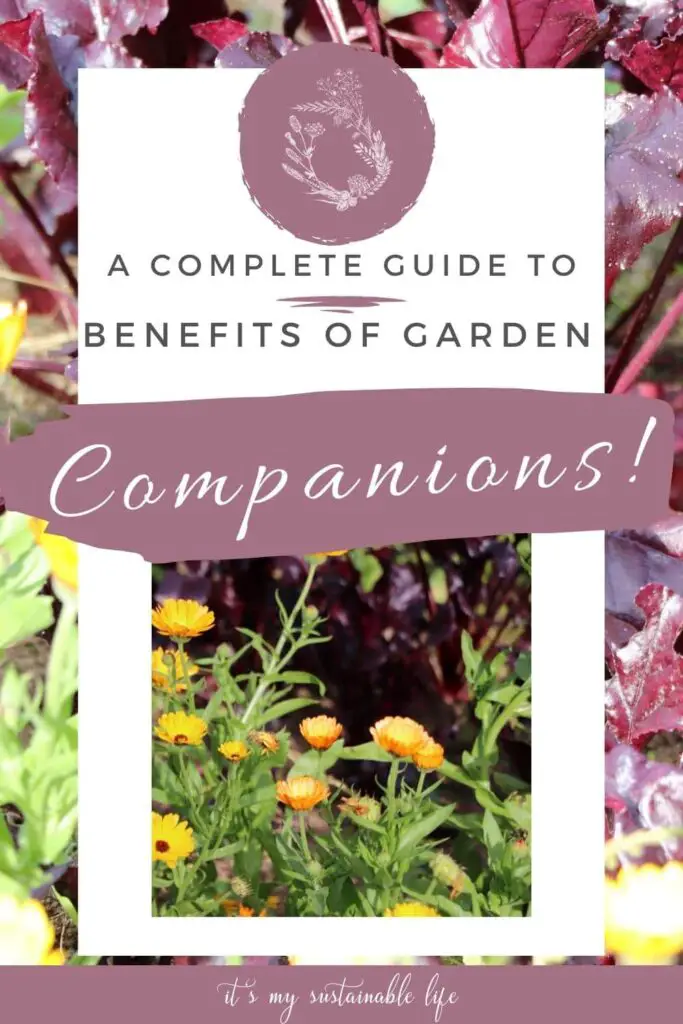
WHAT IS COMPANION PLANTING?
What exactly is companion planting? Basically, in its simplest form, companion planting is the theory that by planting or growing two plants close together, one or both of those plants will benefit from each other in some way.
Also known as nurse crops or intercropping, companion planting mimics nature and how plants naturally grow. In nature, plants don’t grow singularly or with one variety of plant only. They are diverse. Many different varieties and species grow near one another, each with their own unique characteristics & function.
It’s this diversity that creates a symbiotic ecosystem which then translates into a supportive environment for healthy plant growth, biological pest & weed control, reduced disease issues, improved soil conditions, and even better pollination!
The most famous of all intercropping or companion planting combinations may come from the North American Native American tribes. The “three sisters”.
Traditionally, the three sisters’ combination consists of corn, pole beans, and squash. Sadly, the sunflower (the fourth addition) was not mentioned in early stories.
This planting combination was successful and demonstrates just how plants can play nice with one another in the garden. Rather than competing for light and root space, they instead cooperate with one another, each offering varied benefits.
The height of the corn creates a trellis or support for the pole beans, the squash growth shades out any weeds and aids in loss of moisture from the soil, and there is no competition for nutrients. The corn (a nitrogen hog), the pole beans (a nitrogen fixer), and the squash (a nitrogen user) all work synergistically well together in all regards.
Is this scientifically proven? Yes and no.
THE SCIENCE OF COMPANION PLANTING
When it comes to companion planting and the science behind it, there is really little research.
Many scientists believe that the term itself, “companion planting” is too broad a term or too vague to even be considered valid in the scientific community.
Instead, they prefer the terms “intercropping” and “plant associations” which they feel are a bit more credible. They even go further by scientifically debunking the traditional “companion plant” charts, referring to them as entertainment with no scientific standing.
As far as science goes in gardening, the stance is basically either adapt or be able to alter their environment in order to survive, according to Dr. Linda Chalker-Scott.
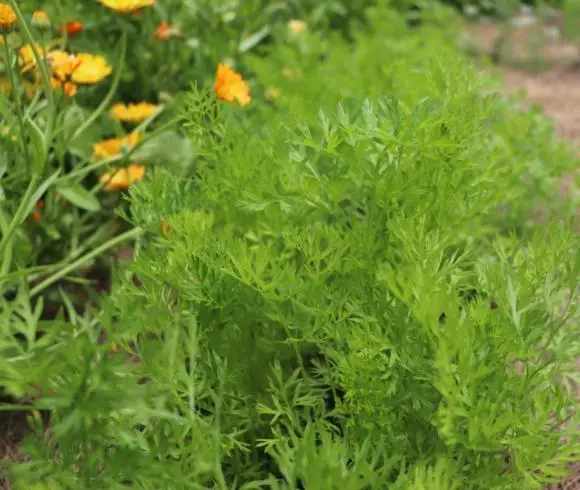
Other studies are focusing on how the scent of fragrant herbs and flowers that are used in companion planting actually cover up the aromatic properties of host plants. Specifically using French marigolds to help lower whitefly populations, largely due to limonene, a chemical found within plants and citrus peels.
The influence of “neighboring companion plants” on aphid populations in greenhouse conditions is looked at in-depth in this abstract. Again, using fragrant herbs (think rosemary, lavender and basil here) to aid in the reduction of aphids on sweet pepper plants.
BENEFITS OF COMPANION PLANTING
With so many companion planting benefits, it’s worth taking an individual look at each more in depth.
MANAGE GARDEN PESTS
Confusion & diversification. That’s what companion planting in the garden provides to many pest issues. Basically, you confuse the pests at hand!
Pests enjoy a banquet. And any easy banquet at that. One that they can easily find and devour. When they can’t easily locate their next meal, pests are deterred due to certain plants being planted right next to their favorite, damage to the overall garden is greatly reduced.
According to an article in Mother Earth News, many have reported success with planting friends by friends in the garden by…
“growing tons of flowers,” with borage, calendula, dill, sweet alyssum, and herbs such as basil, garlic chives and oregano named most frequently.”
MEN
I can attest to this as one of my favorite companion plantings is calendula. Not only am I deterring pests in my garden, I am also the beneficiary of its amazing medicinal properties which I readily take advantage of!
May Be Of Interest
Calendula Flower Uses And Benefits
How To Make And Use Calendula Oil
Companion plantings can also lure beneficial insects, aka the insects which feed off many of the problematic ones.
Hoverflies are one such beneficial. Especially for those who have early season issues with aphids and the like.
By planting cilantro, greek oregano, sweet alyssum as well as many other herbs and flowers that the hoverflies are attracted to amongst your garden plantings, these beneficial insects who feed on aphids will hopefully remain in the area and take care of that pest issue!
Another example is planting borage amongst your plantings which are attractive to both bee’s (pollinator) and wasps (pest-eating).
And don’t forget to lure the birds to the garden area by planting sunflowers! Not only are they beautiful, edible to humans and birds alike, they are also very attractive to pollinators and birds!
Birds love to enjoy a meal here or there on grasshoppers, small insects like flea beetles, cabbage worms and more. By perching on their favorite sunflower, they can take a moment, view the landscape, and stalk their favorite snack.
It’s not all about just luring beneficials however. Think of companion plants as possible deterrents as well.
There are plants which repel and deter certain pests. When considering plants that help deter unwanted pests and lure beneficials include….
- Coriander
- Dill
- Cosmos
- Buckwheat
- Lacy Phacelia
- Marigold
- Fennel
- Mint
- Rosemary
- Lavender
Should you just be starting out, you may want to consider purchasing packages of beneficial and parasitoid insects which you can release once your plantings are flowering!
Pests are not limited to the creepy-crawly kind in the garden. In my humble opinion weeds are a pretty pesky issue.
MANAGE WEEDS
Not sure about you, but any way I can incorporate gardening practices that help with weeds, I’m going to give it a go!
For the past few years I have been leaning toward a no till, permaculture approach to my garden. By doing so I have observed that many beneficial plants self-sow and naturalize.
Sometimes to the point that I need to pull them out (kinda like beneficial weeds 😅), but am happy to do so as I can regulate how many I want growing at any given time, and my chickens get a free feast in the process!
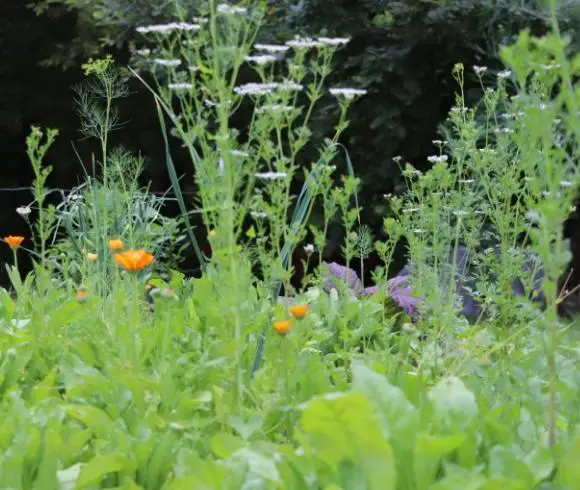
An added benefit to this? Weeds are suppressed by these plants acting as living mulch! When soil is covered with a growing plant, ultimately there is no room for weeds to take hold!
Consider planting a cover crop to aid with just this issue when ground is left bare. Not only is it considered a “green manure”, i.e. healthy and nutritious for your garden, it also acts as a weed barrier. Win! Win!
AIDS WITH DISEASE ISSUES
Again, diversity is key here. When you have a diverse group of plants, unwanted disease issues are hindered from spreading rapidly.
This allows the gardener to take a breath and formulate a course of action for disease treatment sooner.
AIDS WITH SOIL HEALTH
The garden which employs companion plantings & continual plantings of either main crops or cover crops aids the soil in several ways.
- EROSION – Through selective companion plantings, soil structure can be improved. Soil erosion typically stems from environmental elements such as rain & wind, but can also come from overuse and soil disturbances. Root systems that are fibrous (think clover, vetch, and rye as cover crops, grasses, and other ground covers) are good choices to help ease erosion issues. Planting a variety of plants with complex root systems is why companion planting aids with soil issues
- MOISTURE – By utilizing companion planting such as the 3 sisters, vining (pole beans) and tall plants (corn) as well as plants that naturally have large leaves (squash) are wonderful for providing shade for the soil, thus reducing moisture loss
- NUTRIENT – Diversity strikes once again. By planting diverse crops amongst one another the competition for the same nutrients are greatly diminished. This simple fact adds up to less nutrient depletion in the soil. As we’ve already discovered, some plants are givers and some are takers, especially when it comes to nitrogen and nutrients
IMPROVES POLLINATION
By increasing the numbers and diversity of pollinators being drawn to the garden through the diverse plantings offered, improved pollination can be expected.
This is now being researched as shown in the article, “Benefits of Pollinator-Attracting Companion Plants”, taking a look at not only how these beneficial companions aid in attracting pollinators (thus improving pollination in the gardening space) but also at how this can aid with increasing crop yields.
Speaking of which…
INCREASED CROP YIELDS
Implementing inter-croppings which attract pollinators can help increase crop yields.
According to this abstract, cucumber and habanero peppers yields were “significantly greater” during harvest periods when annual companions were planted near.
This makes such sense to me, increased pollination = increased yields.
OFFERS SUPPORT
Through selective plantings (think the 3 sisters here as an example), creating a living trellis or support for vining or climbing plants will be enjoyed with no added effort on our part!
Less work? Yes, please!
SAVES GARDEN SPACE
It seems that no matter how large a garden you are graced with, there is never enough space.
When companion planting is utilized you are not only gardening more efficiently, harvesting increased crop yields, but are able to take advantage of empty garden space which is normally left untouched.
For example, when planting indeterminate tomatoes (tall growing) consider companion plants that are fast growing such as lettuce (which would also take advantage of the shade created by the tall tomato plant.
ADDS BEAUTY
One of the biggest benefits of companion planting in my opinion is the beauty and texture that’s added to an otherwise bland garden scape.
I’ve yet to meet anyone who’s come visiting here on the hill when the garden is in its full glory and not comment on how beautiful it is.
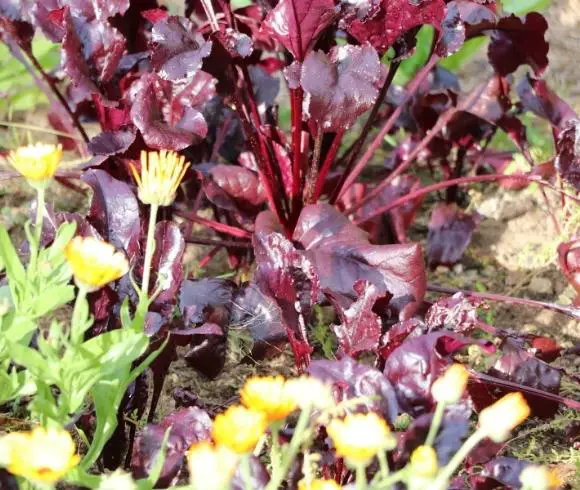
Layered gardens, gardens that have varied heights, color, contrast, and texture are not only the most beautiful to look at, but also the most beneficial to the health of the garden overall. Right down to its roots.
ARE THERE DISADVANTAGES OF COMPANION PLANTING?
There can be no light without darkness, and the practice of companion planting is no different.
Although few, there are several disadvantages of companion planting you may want to consider.
- Increased competition for both water and nutrients in the soil may lead to lower vigor in the garden when the plant choices are off
- The need to always have a “crop” growing in the garden, either a main crop or a cover crop, or weeds will definitely take root
PLANTS TO AVOID WHEN COMPANION PLANTING
Just as there are those plants that play along nicely with others, so too are there certain varieties that you may want to avoid at all costs.
Allelopathy is real my friend. Allelopathy is by definition …
“the chemical inhibition of one plant (or other organism) by another, due to the release into the environment of substances acting as germination or growth inhibitors”
Dictionary
In other words, plants that have developed a defense mechanism to ensure their survival. Ones that don’t play nicely with their neighbors.
Perhaps the most common of these are sunflower (said to not play so nice with tomatoes, soybean, sorghum, rice, mustard, beans, and corn) and black walnut (doesn’t play nice with asparagus, cabbage, eggplant, peas, peppers, potatoes, rhubarb, and tomatoes).
When planting these types of plants, be sure to plant as far away from any victims that you are planning on planting.
That being said, anyone who has gone through my gardening articles and seen images of my garden can easily see that I allow my sunflower to self-sow every year. Whether they have been detrimental when growing in close proximity to any of the no-no’s listed or not have not made such a large impact that I will stop doing so. I feel the benefits (beauty, shade, wildlife and pollinator attraction) far outweigh the loss of a tomato or two 😊
COMPANION PLANTING COMBINATIONS
It can be a bit overwhelming when first beginning to incorporate companion planting into your garden. After all, the combinations and choices are many!
Familiarizing yourself with plants that are definitely considered friends in our gardening endeavors (fortunately there are very few foes) allows us to grow a healthy & beautiful garden.
Taking a page from gardeners of the past, here are a few companion planting combinations that have been successful for us. Although not an exhaustive list, it’s one that should give an idea of the friends and foes in the garden from master gardeners.
| PLANT | FRIENDS | FOES |
| BASIL | Tomato, bean, eggplant, cabbage, cucumber, beet, asparagus, fennel, oregano | Tomato, bean, eggplant, cabbage, cucumber, beet, asparagus, fennel, oregano |
| BEANS | Catnip, cabbage, carrots, cauliflower, corn, cucumber, eggplant, lettuce, marigold, nasturtium, parsley, peas, potato, savory, spinach, swiss chard, radish | Allium (onion, garlic, chives etc), beets, fennel, kohlrabi, pepper |
| BEET | Cabbage, dill, lettuce, onion, potato | Tomato |
| CABBAGE | Beans, beet, celery, cucumber, dill, lettuce, marigold, nasturtium, onion, potato, thyme | Mustard, strawberry, tomato, grape, pole beans |
| CALENDULA | Asparagus, beans, Brassicas, chive, cucumber, leek, peppers, pole beans, radish, sage, tomato, pea, carrots | Dill, parsnip, potato |
| CARROT | COMPANIONS Beans, cabbage, calendula, chive, cucumber, dill, radish, lettuce, onion, pea, pepper, rosemary, sage, and tomato | Potato, parsnip, dill, anise, parsley |
| CORN | Basil, dill, nasturtium, parsley, pea, pole beans, potato, pumpkin (and Cucurbits), radish, squash | Brassicas (cabbage family), celery, tomato |
| CUCUMBER | Beans, beet, cabbage, carrot, corn, dill, lentil, marigold, nasturtium, onion, oregano, radish | Potato, melon, mint, sage |
| DILL | Brassicas, cabbage, corn, cucumber, lettuce, onion, tomato (when dill is young only) | Nightshades (peppers, eggplant, tomatoes (once dill has matured)) and Umbellifers (angelica, caraway, carrots, fennel) |
| MARIGOLD | Basil, broccoli, cabbage, cucumber, eggplant, gourd, k | I don’t know of any! Love to hear from you if you do! |
| PARSLEY | Asparagus, carrot, corn, chives, onion, peas, pepper, tomato | Alliums (onion, garlic, shallots), lettuces |
| POTATO | Beans, beet, cabbage, calendula, corn, eggplant, nasturtium | Celery, cucumber, tomato |
| TOMATO | Asparagus, basil, bean, borage, cabbage, carrot, lettuce, marigold, onion, parsley, peas, sage, squash, mint, chive, garlic, lemon balm, calendula, and nasturtium | Cabbage, sunflower, corn, dill, eggplant, pepper, potato, fennel, and black walnut |
By no means is this an exhaustive list. It should, however, give the beginner companion planting gardener a few ideas of what can be planted with what.
COMPANION PLANTING FRIEND & FOE CHART
Does my preferred plants, ones that I consider to be the best friends & foes, aka companion plants, differ from the above list? Yup.
I have created for you a companion planting chart (PDF) which can be downloaded, laminated, and used year to year, available in my ETSY shop!
Interested in further printables to aid with all your Garden Management? Be sure to take a look at my comprehensive Garden Management Planner as well!
These organizational printables will have your garden thanking you 😊
HELPFUL TIPS
These general guidelines or tips for taking advantage of the benefits of companion planting are always a welcome reminder to the experienced gardener and help to simplify the process.
NATURAL PEST REPELLENT PLANTS
These plants are keepers for any garden looking to utilize natural pest control methods. It’s worth repeating a few…
- Plant nasturtium or stinging nettle to help control Aphids and whiteflies away
- Marigolds shoo mosquitoes, cabbage worm and Mexican bean beetles away
- Borage repels tomato worms
- Plant mints to keep ants at bay
- Basil keeps mosquitoes and flies at bay
- Chrysanthemum contains pyrethrum and will help keep ants, and Japanese beetles away
- Rosemary and wormwood help control slugs
- Garlic controls snails, and helps repel cabbage pests (worms, moths, loopers)
- Catnip helps repel flea beetle
- Oregano repels cabbage moths
HERBS MAKE GREAT COMPANION PLANTS
Throwing herbs into the mix is always a good idea when companion planting. Not only do many pests dislike certain herbs, but they offer an edible interest and beauty to the mix.
Consider planting ….
- Dill (not with carrots) said to enhance the flavor of cabbages, cukes, lettuce, and onions
- Oregano
- Parsley makes a great companion for corn and tomatoes
- Thyme
- Sage (not with cukes) is said to aid cabbage, carrot, and tomato
- Rosemary (not near carrot, potato, pumpkin) helps Brassicas, chive, beans, carrots, onion, and parsnip
COMPANION PLANTING AND CROP ROTATION
Maintaining optimal health in any garden, no matter the size, includes crop rotation. Not sure of what crop rotation is? Be sure to take a look at my in-depth article on the “Benefits Of Crop Rotation”.
Practicing one modality of garden maintenance is great. When you combine the two, crop rotation AND companion planting, you create a powerhouse of soil maintenance!
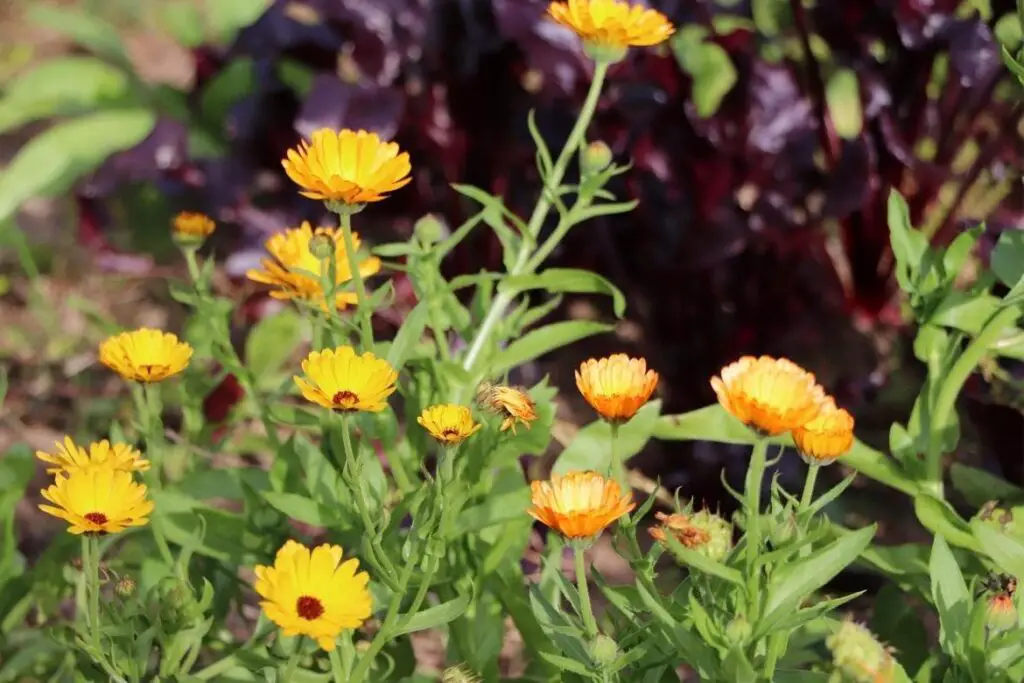
These two gardening practices allow nature to take care of itself in the garden. As nutrients are removed from some plantings, by selective plantings that not only replace those diminished nutrients but also aid in any present plantings, equals one positive result. Increased production, harvests, less weeds & pests, and more down time for me 😊
By no means does putting into practice these gardening methods replace proper garden preparation, and continued garden maintenance. Maintaining healthy soil translates into healthy plants. By putting into place ALL the gardening techniques we can muster will create one thing of beauty. The garden.
Although it may seem like a lot of information here, with a little planning and selective planting your garden will reap all the benefits of companion planting!
What will you be planting to take advantage of the benefits of companion planting?
Love, Light, & Laughter ~

SHOP THIS ARTICLE
Enjoy this article? Please consider sharing it on your favorite social media channel! Want more? Subscribe below for the occasional update with all the “happenings on the hill”!

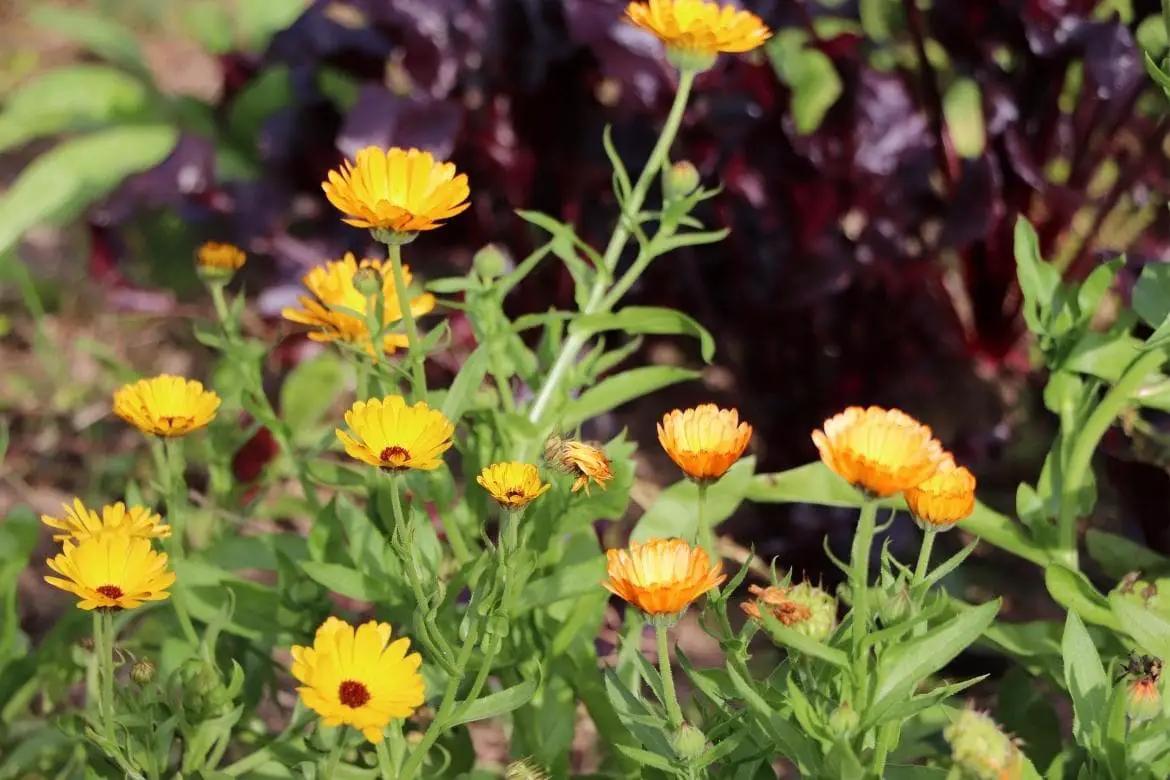

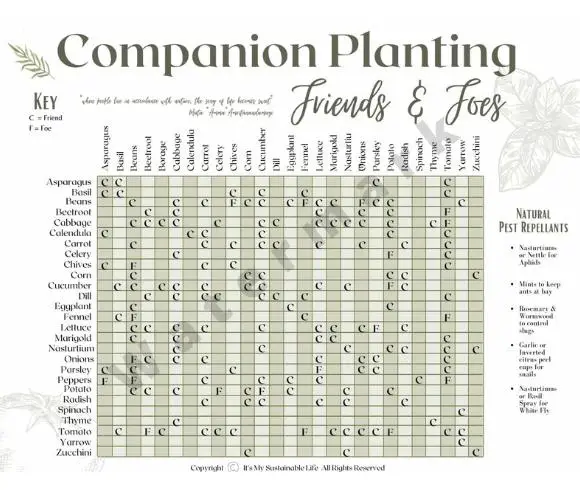
16 comments
Companion planting is so beneficial. We love using Marigolds.
I do love companion planting! Thanks for such a great list!
There is a lot of great information here on companion planting. I don’t know a lot about it, so I really appreciated the chart on what plants are friends and which are foes. I’ll keep this in mind as I do a little planting soon.
This is a comprehensive pst on companion planting. I think it’s incredibly cool that it confuses the pests. Great article!
Hi Suzan,
I’m popping over from the Hearth and Soul link party. Thank you for this incredibly detailed blog! It’s full of useful information. Companion planting is something that I need to give more thought to this year to get the most out of everything we grow. Love your blog and glad I found you.
I always knew companion planting was beneficial (and have actually done it before), but I didn’t realize how beneficial until I read this post! I enjoy gardening, but am a complete novice. I will definitely save this for future use.
I love using marigolds as a companion plant. The flowers are beautiful and I like to eat them too.
Marigolds are so beneficial on many levels! So great you put them to good use 🤗
I love it when plants play nice together. I utilize the benefits of companion planting in my own veggie garden.
LOL, right?
This is a great guide on the benefits of companion planting. The friends and foes chart is especially helpful.
Your article was so interesting to me because apparently I’ve been companion planting in my raised garden bed and not even knew it. I never knew this terminology!
So much great information about companion planting here! I have to admit, I did not know much about this and could have avoided some issues with my gardens in the past if I had learned about companion planting. I am definitely bookmarking this post for when I start my new garden (hopefully this Spring!). Thank you for always delivering great info!
Thank you, Morayma! So happy you found it helpful. Happy planting!
Wow! Lots of interesting information in this article — pinned for future reference. I’ve heard of companion planting but never understood exactly how it works. Thanks for explaining the concept.
Carol
I am going to plant some chrysanthemums this year. We get bad Japanese beetles that eat our raspberry leaves. Great post!